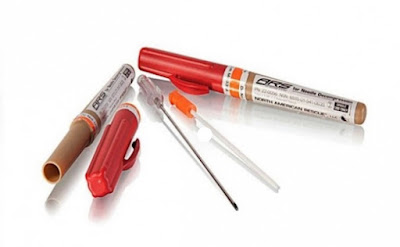Chest Decompression Needles; Vital kit or tactical talisman?
As will be the case in this often trend driven industry, yet another tactical talisman has entered the must have lists of many a preparedness minded individual. You’ve all seen them, or bought them, yet very few have any legitimate training or authority to even posses them. We are talking about the chest decompression needle. It must finally be said, please STOP; you know not what you do.
I have been an instructor in most disciplines of Fire, EMS, Technical Rescue Operations, and now Firearms for two decades, operated on the streets for 20 years. Like most in my service, I have responded to thousands of calls that include pretty much any insult to the human form an individual could imagine. But guess what, I’ve seen more double rainbows in my life than I’ve even heard of pre-hospital tension pneumothorax decompressions.
You might be interested to know that ER physicians have an approximately 68% success rate of successfully detecting tension pneumothorax within the controlled environment of an emergency room. Yet thousands of people believe they can pull it off with no training in the uncontrolled environment of a trauma scene. There are also a great number of false positives that end up “darted” that complicate patient condition greatly. This procedure is an extraordinarily rare need and NOT a “ground ball” to perform.
I am very happy that there has been an increased focus on civilian trauma management education. Please stop calling it “tactical” or “extreme” to sound cool; it’s just trauma management. I instruct civilians. I instruct my family and friends. So I obviously believe it is vitally important that you are able to stop bleeding and live, whether it’s a gunshot wound or a workshop injury. I encourage everyone to attend a class and learn real world LSIs (Life Saving Interventions). Afterward, buy some appropriate kit and strategically locate it. You are good to go. A well intended tip; Like the shooting world, there are many instructors on this topic who’s credentials are suspect to say the least. Vet your instructors!
Some folks have taken the next step and decided to attend an Emergency Medical Technician course. This is a great effort, easily completed in a few weeks, but be careful, far too often I see these folks carrying more advanced care crap in their kits than many of my physician friends. The quickest way to not be an EMT anymore is to carry advanced kit, made much worse if you dare attempt to use it. If you are an EMT, you are required to stay within your scope of practice BY LAW, and decompressing a pnuemo isn’t in your lane.
Hypothermia management aside, there is no trauma intervention easier to master than modern bleeding control. This mastery however only comes from continual training, as these skills are perishable even for the professionals. The equipment used is top notch, represents a statistically relevant injury occurrence, and are actually LEGAL for civilians to obtain and posses without a prescription.
I understand people’s attraction to do-dads, especially items of a tactical nature. I understand that there is a certain implied “CDI” factor to visually conveying an “I got this” attitude by wearing a full blow out kit on your belt. But when you take up a 3 ¼ inch(or longer), 10 or 14 gauge needle and attempt to place it perfectly within the plural space without any confirmation methods or true understanding of the indications or contra-indications, you have ventured out of your league. The patient outcome implications can be severe, and you will be challenged. Your good intentions, and one-day class on the matter cannot help you.
Now I understand this will have the potential to offend a great many well-intended people but know your efforts to learn are a tremendous positive step. Some of my most enjoyable teaching experiences come from working with civilians that truly wish to expand their skillset in appropriate trauma management techniques. I’m just sharing that there are FAR more important techniques and concepts upon which you should be focusing your time, effort, and money.
I discussed this matter recently with a physician friend of mine. Not some technically a doctor type, but a down and dirty, aggressive young doc that is a driving force in trauma management and EMS operations in a significant metropolitan. For the ninjas among us, also a Brazilian jujitsu loving SWAT team member, with extensive military deployment experience in our recent conflicts. He echoed my sentiment saying frankly, “Too many folks just want to do the sexy advanced stuff. They need to be concentrating on BLEEDING CONTROL, AIRWAY MANAGEMENT, HYPOTHERMIA, and EXFIL.” Hypothermia and exfil are so ridiculously easy, but blankets and truck beds just aren’t that interesting. If I invented the Tacti-Quilt and patented Tac-Exfil Truckbeds I may be a millionaire sooner than I thought. But I digress. My friend added some other expressions against the absurd trend of civilians carrying Tension Pnuemo Relief kits, but I’ll keep this family friendly. Sincere thanks for keeping it real Doc.
In closing, there are many myths that have in recent years been debunked through real science and research. Back-boarding, Big bore IVs, TQ injury disasters, just to name a few. Add to that list, the misguided expectation that you aren’t on the cool kid list without a chest decompression needle. Stick to the list above from the good doc, with quality up to date training, and you are good to go!
*For your questions on civilian emergency training, or to set up a Real World Civilian Response class, visit trainwithwillis.com or traingunset.com.




Comments
Post a Comment